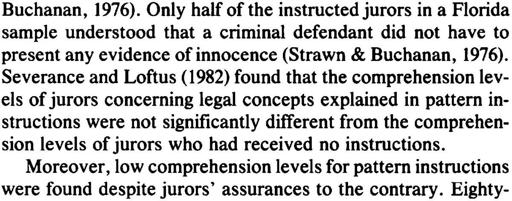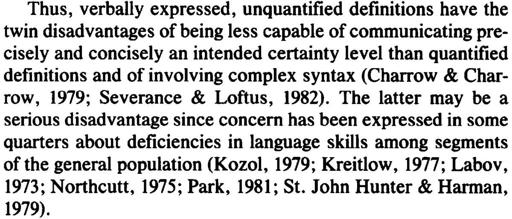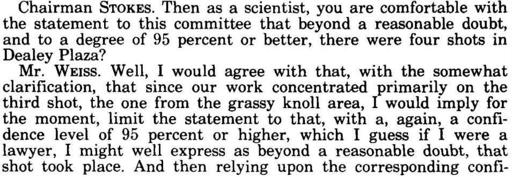Read Impossible: The Case Against Lee Harvey Oswald Online
Authors: Barry Krusch
Tags: #Non-Fiction, #History
Impossible: The Case Against Lee Harvey Oswald (12 page)

The instructions did little, if anything, to increase juror comprehension (Kagehiro, p. 194):

To see just how confused jurors can be, and the effect that vague terms have on determinations of innocence or guilt by jurors, the following table related to juror verdicts tells you all you need to know.
The table below has different standards of proof subdivided into three columns,
preponderance
(for “preponderance of evidence”),
clear and convincing
(for “clear and convincing evidence”), and
reasonable doubt
(for “beyond a reasonable doubt”).
The layout of the standards, left-to-right, is no accident: the easiest standard to meet is the
preponderance of evidence
standard, the next easiest standard is the
clear and convincing
standard, and the hardest standard is
beyond a reasonable doubt
.
So, going from left to right across the rows in the table, the numbers ought to
decrease
: if a plaintiff could win
50%
of their cases using a
preponderance
standard on body of evidence x, then you might expect they could only win, say,
25%
of cases using a
reasonable doubt
standard on the same evidence. You certainly wouldn’t expect the opposite.
To test the effect of methods of instruction on juror perception of the standards, and to see if the instructions produced the predicted result, Kagehiro decided to use several methods of definition, one using the verbal instructions used in a courtroom (in the screen capture below, the California pattern from the Committee on Standard Jury Instructions along with the Texas Supreme Court’s instruction in
State v. Addington
(1979)), and one of the others a quantified (numeric) standard based on probability terms.
In one of the more alarming developments in the literature, Kagehiro found that
the
prototypical judicial approach using vague language produced a result opposite from what ought to have been expected!
(Kagehiro, p. 197):

There it is, in black-and-white, that the wrong method of providing instructions can result in jurors seeing black as white.
Kagehiro discovered essentially the same problem with other types of instructions, and concluded that “[a]cross the studies, only the quantified definitions consistently had their intended effect” (Kagehiro, p. 196). Kagehiro summarized the problem with unquantified definitions:

Well, I’ve learned my lesson, and I think you have too. So what does this mean to us? Just this: because Oswald was deprived of his right to a jury trial — as well as a judge who could provide a
definition
of the reasonable doubt standard that we are compelled to apply —
we
need to discover what constitutes reasonable doubt; to make sure that we do the job right, we are going to learn from what the Kagehiro study has taught us.
To achieve ironclad deductive certainty —
and
to satisfy the requirements of due process as a not insignificant side benefit — we must define “reasonable doubt”
objectively,
in
quantified
terms.
Let’s put some meat on these bones.
Chapter 3
Reasonable Doubt:
An Objective Standard
So, how is one to define “reasonable” objectively? At first glance, this would seem to be extremely difficult, if not impossible. For most of us, “reasonable” seems to embody the quintessential essence of wishy-washiness. And yet, once we more closely analyze the concept, it becomes evident that we can translate the term into a number, and, once this is done, we can then set a lower and upper numerical range for “reasonable” within which that number must fall, based on well-established societal norms.
The ease of doing this can be more readily seen when we talk about reasonable doubt from the standpoint of a concept easier to understand,
confidence level
.
We can make this transition because doubt and confidence stand at the opposite ends of the spectrum, and that any statement expressed in terms of
doubt
can simultaneously be expressed in terms of
confidence
, both of which can be expressed
numerically
.
The following continuum will illustrate this point:

The numbers at the top of the line indicate percentages. If you are 100% confident that an event will occur, then you are absolutely sure it
will
occur; to state it another way, we say you have “no doubt” it will occur. On the other hand, if you are 0% confident that an event will occur, then you are absolutely sure it
will not
occur, the most extreme doubt possible.
The concept of confidence level is typically used in weather forecasts. When the weather forecast for tomorrow says that there is “an 80% chance of rain,” this means that the meteorologist is 80% confident that it will rain tomorrow. But, to the point just mentioned, this could be expressed another way, that it is 20% doubtful that it will not rain.
Notice here that doubt and confidence are
inversely related
: to say that one is 70%
confident
of a proposition is to simultaneously say that one is 30%
doubtful
of a proposition.
Why do meteorologists express their propositions in terms of confidence versus doubt? Because, as you have undoubtedly seen, it is easier to conceive of a proposition in terms of confidence level rather than that of doubt (e.g. “80% confident that it will rain” is easier to conceptualize than “20% doubtful that it will not rain,” since the latter utilizes a double negative), even though the two statements are essentially the same, just expressed in opposite ways.
So, going forward, for the purposes of clarity, we will attempt to translate the concept of reasonable doubt into a percentage expressed as a confidence level, and we will do that by asking this question:
when someone uses the phrase “beyond a reasonable doubt,” to what
specific
percentage level of confidence does this translate?
If we are able to nail down the concept of reasonable doubt to a specific confidence level, we will have a useful analytical tool that will enable us to precisely measure the effect evidence will have on reasonable doubt.
To find our number, let’s start by working our way from both ends. Suppose you are
100%
confident that a defendant is guilty. Then, obviously, you have 0% doubt (absolutely no doubt) that the defendant is guilty, which is obviously
well past
the reasonable doubt standard. This is the confidence level that the prosecutor, ideally, wants you to have for his charge. You
are
confident beyond a reasonable doubt.
On the other hand, suppose you are
0%
confident that a defendant is guilty. Then, you have 100% doubt that the defendant is guilty, which needless to say, falls
well short
of the reasonable doubt standard. In other words, to dramatically understate the matter, “you are
not
confident beyond a reasonable doubt.”
So, since we know that
100%
confidence easily
surpasses
the reasonable doubt standard, and
0%
confidence obviously
does not
, what is the number that should be used to demarcate the division between reasonable and unreasonable doubt? 50%? 75%? Some higher number?
To find the answer to this question, let’s start with a rather mundane example which will lead us to a very useful conclusion:
You are a very well-paid office manager, and have been asked by the President of the firm to plan the office picnic. The President is a rather obsessive fellow, and he
loves
picnics in the sunshine. In fact, if you make a mistake, and choose a day where the picnic is aborted by rain, the President will
fire you
. Period.
Gulp
! Accordingly, it is your task to pick a day in the summer where you are confident it will be sunny
beyond a reasonable doubt
.
Now, ask yourself, what confidence level will you require before you pick a day for the picnic? Remember, your very well-paid job is at stake!
Suppose you assign this important task to your assistant, who comes to you and says that he has found the day. You check the meteorological records, and you find out that, on average, rain has fallen on that date 50% of the time. In other words, if you choose that date, you are 50% positive that it will
not
rain (which means that you are 50% positive that it
will
rain).
Now, would you chance your very well-paid job on a coin flip? Obviously not! So you tell your assistant to go back to the drawing board. And he comes back to you and says he has found a much better day. You check the meteorological records, you find out that rain has fallen on that date 25% of that time — a 75% chance of a sunny day. That is better, but is it good enough? You know that there is a one out of four chance it is going to rain. Would you risk your job on
two
coin flips? Two is better than one, but I think we all will agree you can do a lot better than that.
So you tell your assistant to go back again, which he dutifully does. This time, the records show that for this new date rain has fallen historically on only 10% of the days, which means that there is a 90% chance of sunshine, or, a 1 out of 10 chance. Much better, but still . . . looking at this decision from a Russian roulette perspective (where your job is at stake), choosing that date would be like playing with 10 chambers and one bullet! Would you want to play Russian roulette with that level of confidence?
I think we can all agree that a 90% confidence level is not adequate, even when it is only your job on the line. Can you imagine how much higher that confidence level would need to be if you (or someone you knew) were faced with the electric chair — that is to say, certain death?
Instantly, we can see that the reasonable doubt standard, expressed as a confidence level,
must
be higher than 90%. Of course, it also
must
be lower than 100%, since absolute certainty is not required to convict defendants, because if that were the standard, very, very few defendants, including the guilty ones, would be convicted.
So what is the
right
number? Choosing wisely is critical, because if a mistake is made, we not only send the innocent to jail, we also let the guilty go free, not to mention that we reduce confidence in our overall political system, a very nasty side effect of slipshod procedure.
Between the 90% standard and the 100% standard, there is bound to be some disagreement, but at least this hypothetical has established the parameters:
The reasonable doubt standard, expressed as a confidence level, must be
higher
than 90% and must be
lower
than 100%.
Of course, eternal debate could center on whether the number should
exactly
be 90.0001% or 99.9999%, or any number in between, and since we currently lack an objective way to make this determination, we will simply split the difference for the time being, and provisionally stipulate the number to be 95%, which gives us the following statement:
The reasonable doubt standard, expressed as a confidence level, is 95%.
What does this mean? It means that
in a capital murder case
,
If you are asked to find someone guilty “beyond a reasonable doubt,” you need to believe that there is a 95% chance they are guilty!
50% doesn’t cut it.
75% doesn’t cut it.
And, in fact, 90% doesn’t cut it.
When you will be sending someone to the electric chair, you need to be really, really sure!
But, at this stage, someone is likely to ask, “can we really make such a broad determination from one hypothetical situation?” The answer is no: it is going to take more than one benchmark to establish these parameters. Therefore, we need to look at other socially accepted norms to inform our decision.
Our starting point could be based on an
innocent versus guilty conviction ratio
: if 100 people are to be given the death penalty, and some of them turn out to be innocent, what is the number of innocent people murdered by the State that ought to be acceptable in a civilized society? Yes, it turns out that our confidence level will directly translate into innocent deaths (i.e., a confidence level requirement of 50% will result in many more innocent deaths than one of 99%), thus instantly revealing its importance, as the Supreme Court noted in the
Winship
case (
Winship
at 364; emphasis supplied):
It is critical that the moral force of the criminal law not be diluted by a standard of proof that leaves people in doubt whether innocent men are being condemned.
According to the Supreme Court, the moral force of the criminal law comes from its legitimacy, and, if the justice system is seen merely as a high-profile version of Russian Roulette, where the guilty compete for the same electric chair as the unlucky, that legitimacy suffers. Consequently, there are
utilitarian
reasons (if not
moral
ones) to have a standard accepted by the community.
So, as a member of that community, how would you feel about
5
innocent people sentenced to death for every
100
convicted? If you feel that number is too
high
, then you believe that the 95% number is too
low
(kudos to you!). How would you feel if only
1
innocent person was sentenced to death for every
100
people convicted? If that number is acceptable to you, then you believe that the number should be 99%.
1
I think it ought to be obvious that any argument that can be made against the 95% number from the
innocent-persons-killed
criterion (a criterion mandated as essential by the Supreme Court, not to mention our own morality) would be that it is
too low
, not that it is
too high,
for a society that promises its citizens the right to “life, liberty, and the pursuit of happiness,” and therefore ostensibly unwilling to declare that this right wasn’t as inalienable as advertised.
Apart from this legal-based utilitarian argument, are there other domains in society that can inform this issue? Yes, the domain of
science
, in evaluating the truth of hypotheses. To this point, Dr. James Fetzer (a PhD in the philosophy of science, author of 20 books in that field, and the Distinguished McKnight University Professor Emeritus at the University of Minnesota) noted in his book
Assassination Science
, that “hypotheses in science are rejected when their improbability equals or exceeds 1 in 20.” (
Assassination Science
, p. 367). In other words, a hypothesis with less than a 95% confidence level is rejected. From this perspective, the 95% confidence level is precisely the demarcation point.
Further proof that this number, or a number extremely close to it, is typically used in science to establish the validity of hypotheses was provided in testimony given to the House Select Committee On Assassinations on December 29, 1978 by Mark Weiss, a professor in the Department of Computer Science of Queens College of the City University of New York. In that testimony, related to the number of shots that were fired in Dealey Plaza on November 22, 1963 (as indicated by an audio recording), Professor Weiss indicated that 95% could be utilized as a demarcation point for the reasonable doubt standard by an attorney (5 HSCA 583):

